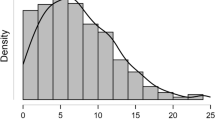Abstract
Bivariate analyses were utilized in order to identify the relations between scores on the Compulsive Sexual Behavior Inventory (CSBI) and self-report of risky sexual behavior and drug abuse among 482 racially and ethnically diverse men and women. CSBI scores were associated with both risky sexual behavior and drug abuse among a diverse non-clinical sample, thereby providing evidence of criterion-related validity. The variables that demonstrated a high association with the CSBI were subsequently entered into a multiple regression model. Four variables (number of sexual partners in the last 30 days, self-report of trading drugs for sex, having paid for sex, and perceived chance of acquiring HIV) were retained as variables with good model fit. Receiver operating characteristic (ROC) curve analyses were conducted in order to determine the optimal tentative cut point for the CSBI. The four variables retained in the multiple regression model were utilized as exploratory gold standards in order to construct ROC curves. The ROC curves were then compared to one another in order to determine the point that maximized both sensitivity and specificity in the identification of compulsive sexual behavior with the CSBI scale. The current findings suggest that a tentative cut point of 40 may prove clinically useful in discriminating between persons who exhibit compulsive sexual behavior and those who do not. Because of the association between compulsive sexual behavior and HIV, STIs, and drug abuse, it is paramount that a psychometrically sound measure of compulsive sexual behavior is made available to all healthcare professionals working in disease prevention and other areas.


Similar content being viewed by others
References
AERA, APA, & NCME. (1999). Standards for educational and psychological testing. Washington, DC: Wayne J. Camara.
Bancroft, J., & Vukadinovic, Z. (2004). Sexual addiction, sexual compulsivity, sexual impulsivity, or what? Toward a theoretical model. Journal of Sex Research, 41, 225–234.
Bewick, V., Cheek, L., & Ball, J. (2004). Statistics review 13: Receiver operating characteristic curves. Critical Care, 8, 508–512.
Carnes, P. (1991). Don’t call it love: Counseling the sexual addict. Minneapolis, MN: CompCare.
Coleman, E. (1987). Sexual compulsivity: Definition, etiology, and treatment considerations. Journal of Chemical Dependency Treatment, 1, 189–204.
Coleman, E., Horvath, K. J., Miner, M., Ross, M. W., Oakes, M., Rosser, B. R. S., et al. (2009). Compulsive sexual behavior and risk for unsafe sex among Internet using men who have sex with men. Archives of Sexual Behavior, 39, 1045–1053.
Coleman, E., Miner, M., Ohlerking, F., & Raymond, N. (2001). Compulsive Sexual Behavior Inventory: A preliminary study of reliability and validity. Journal of Sex and Marital Therapy, 27, 325–332.
Coleman, E., Raymond, N., & McBean, A. (2003). Assessment and treatment of compulsive sexual behavior. Minnesota Medicine, 86, 42–47.
Cooper, A., Scherer, C. R., Boies, S., & Gordon, B. (1999). Sexuality on the internet: From sexual exploration to pathological expression. Professional Psychology: Research and Practice, 30, 154–164.
Dowling-Guyer, S., Johnson, M. E., Fisher, D. G., Needle, R., Watters, J., Anderson, M., et al. (1994). Reliability of drug users’ self-reported HIV risk behaviors and validity of self-reported recent drug use. Assessment, 1, 383–392.
Edwards, J. W., Fisher, D. G., Johnson, M. E., Reynolds, G. L., & Redpath, D. P. (2007). Test-retest reliability of self-reported drug treatment variables. Journal of Substance Abuse and Treatment, 33, 7–11.
Gullette, D. L., & Lyons, M. A. (2005). Sexual sensation seeking, compulsivity, and HIV risk behaviors in college students. Journal of Community Health Nursing, 22, 47–60.
Kafka, M. P. (2010). Hypersexual disorder: A proposed diagnosis for DSM-V. Archives of Sexual Behavior, 39, 377–400.
Kalichman, S. C., & Cain, D. (2004). The relationship between indicators of sexual compulsivity and high risk sexual practices among men and women receiving services from a sexually transmitted infection clinic. Journal of Sex Research, 41, 235–241.
Kalichman, S. C., & Rompa, D. (1995). Sexual sensation seeking and sexual compulsivity scales: Reliability, validity and HIV risk behavior. Journal of Personality Assessment, 65, 586–601.
Lambert, J., Lilly, E., & Lipkovich, I. (2008, March). A macro for getting more out of your ROC curve. Paper presented at the SAS Global Forum, San Antonio, TX.
Miner, M. H., Coleman, E., Center, B. A., Ross, M., & Rosser, B. R. (2007). The Compulsive Sexual Behavior Inventory: Psychometric properties. Archives of Sexual Behavior, 36, 579–587.
Muench, F., & Parsons, J. T. (2004). Sexual compulsivity and HIV: Identification and treatment. Focus, 19(6), 1–5.
Pepe, M. S. (2000). Receiver operating characteristic methodology. Journal of the American Statistical Association, 95, 308–311.
Zweig, M. H., & Campbell, G. (1993). Receiver-operating characteristic (ROC) plots: A fundamental evaluation tool in clinical medicine. Clinical Chemistry, 39, 561–577.
Acknowledgments
This research was funded, in part, by contracts H700938 and H700939 from the Office of AIDS Programs and Policy, County of Los Angeles, CA. Further support was provided by contract 28569 from the Department of Health and Human Services, City of Long Beach, CA. Support for Dr. Napper was provided by fellowship F32DA022902 from the National Institute on Drug Abuse.
Author information
Authors and Affiliations
Corresponding author
Rights and permissions
About this article
Cite this article
Storholm, E.D., Fisher, D.G., Napper, L.E. et al. Proposing a Tentative Cut Point for the Compulsive Sexual Behavior Inventory. Arch Sex Behav 40, 1301–1308 (2011). https://doi.org/10.1007/s10508-010-9712-2
Received:
Revised:
Accepted:
Published:
Issue Date:
DOI: https://doi.org/10.1007/s10508-010-9712-2




